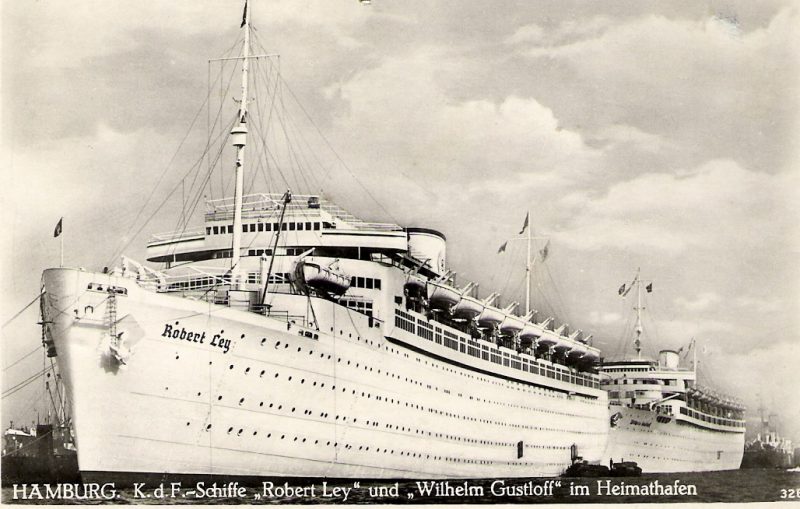
It is still the case – the sinking of the Wilhelm Gustloff remains the biggest maritime disaster in history. Over 9,000 people – mostly women and children – perished in the Baltic Sea when a Soviet submarine fired three torpedoes into the port side of the Gustloff on January 30, 1945.
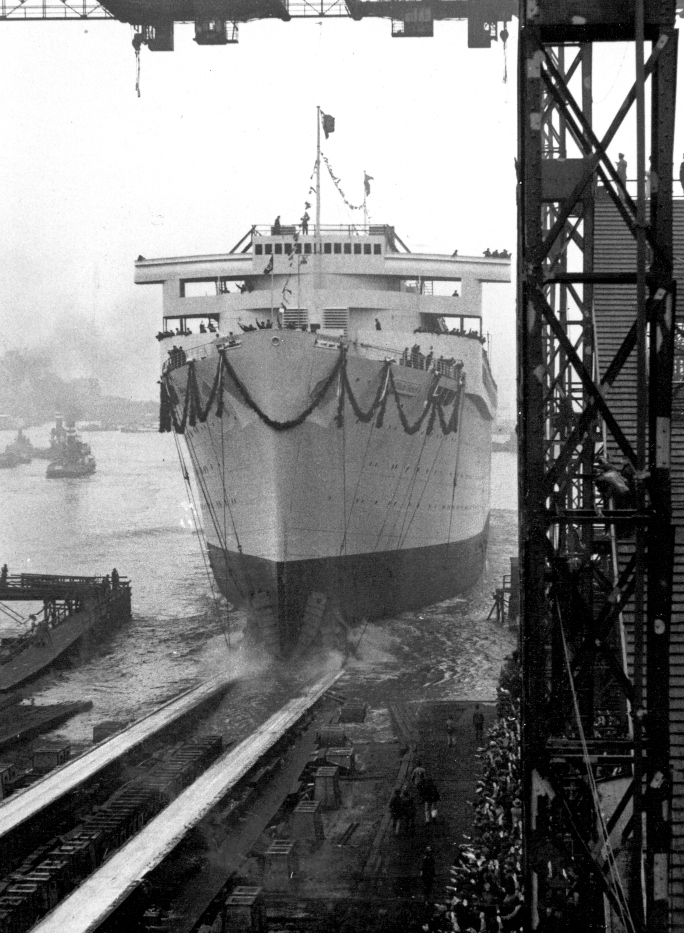
Flags and swastika banners festooned the quay and arms raised in the notorious Heil Hitler salute as the ship sailed forth showing an uneasy world the full industrial might of Nazi Germany.
The Gustloff had been envisioned as one of the most luxurious cruise-ships of the day. She was to have large communal halls and open decks so that passengers could make optimum use of the space offered by the ship. As near as was possible, her cabins were all to be the same size. This was the same for both passengers and crew, to create a feeling of equality onboard ship…although only the passenger cabins would be permitted to have oceanfront views. To continue the feeling of equality, there would only be one class onboard ship – the cruise-class.

The Wilhelm Gustloff was 684ft long (nearly a full 200ft shorter than the Titanic), she weighed 26,000GRT (Gross Registered Tons), a little more than half of the Titanic and she carried 417 crew and 1,460 passengers, making for a total complement of 1,877. By comparison, the Titanic could take over three thousand passengers and crew. She had eight decks, a top speed of fifteen knots (18mph) thanks to two propellers and engines capable of producing 9,500hp. She had twenty two lifeboats and twelve transverse bulkheads creating thirteen watertight compartments
With all these characteristics, Hitler hoped that the Wilhelm Gustloff would be a floating pleasure-ship, taking Germans all around Europe. She would be comfortable, open and safe to travel on and would be a symbol of German superiority and ingenuity. She was designed to be a cruise-ship for the masses, for ordinary German working men and women, a sign that the Fuhreur and the Reich cared about the ordinary, hardworking German citizen. To the German worker, the Gustloff was to be the ultimate prize and reward as a holiday for all his hard work. But sadly, it was not to be. During the summer of 1939, she was pressed into service to bring the Condor Legion back from Spain after the victory of theNationalist forces under General Francisco Franco in the Spanish Civil War. From September 1939 to November 1940, she served as a hospital ship, with her official designation being Lazarettschiff D.
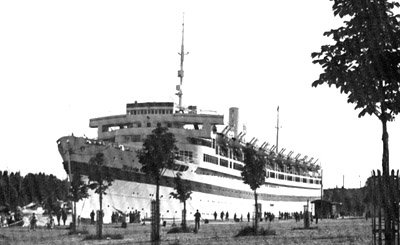
Beginning on 20 November 1940, the medical equipment was removed from the ship and she was repainted from the hospital ship colors of white with a green stripe to standard naval grey. As a consequence of the British blockade of the German coastline, she was used as an accommodations ship (barracks) for approximately 1,000 U-boat trainees of the 2nd Submarine Training Division in the port of Gdynia, which had been occupied by Germany and renamed “Gotenhafen“, located near Danzig. In 1942, SS Cap Arcona was used as a stand-in for RMS Titanic in the German film version of the disaster. Filmed in Gotenhafen, the 2nd Submarine Training Division acted as extras in the movie.Wilhelm Gustloff sat dockside for over four years, until she was put back in service to transport civilians and military personnel as part of Operation Hannibal.
Operation Hannibal was the naval evacuation of German troops and civilians from Courland, East Prussia, and Danzig-West Prussia as the Red Army advanced. Wilhelm Gustloff‘s final voyage was to evacuate German refugees and military personnel as well as technicians who worked at advanced weapon bases in the Baltic from Gdynia, then known to the Germans as Gotenhafen, to Kiel.
The ship’s complement and passenger lists cited 6,050 people on board, but this did not include many civilians who boarded the ship without being recorded in the official embarkation records. Heinz Schön, a German archivist and Gustloff survivor who carried out extensive research into the sinking during the 1980s and 1990s, concluded that Wilhelm Gustloff was carrying a crew of 173 (naval armed forces auxiliaries), 918 officers, NCOs, and men of the 2 Unterseeboot-Lehrdivision, 373 female naval auxiliary helpers, 162 wounded soldiers, and 8,956 civilians of which an estimated 5,000 were children, for a total of 10,582 passengers and crew. The passengers besides civilians included Gestapo personnel, members of the Todt organization and Nazi officials with their families.
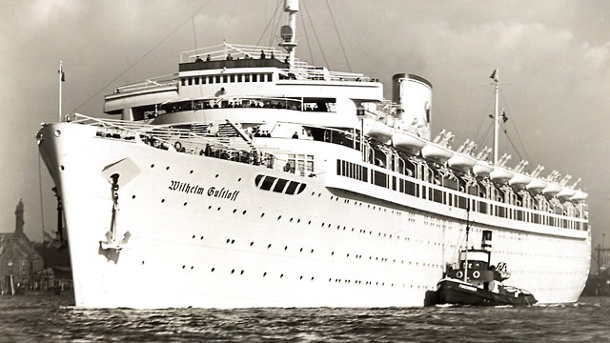
– Discharged from the Soviet Navy.
– Arrested and sent to Siberia for three years’ hard labour.
– Diagnosed with cancer.
– Reinstated with his title of captain.
– Given a military pension.
– Given a ceremony honouring his actions during the Second World War.
Just three weeks after these last three incidents, Marinesko died, in October of 1963. He was fifty years old.
The ship left Gotenhafen early on 30 January 1945, accompanied by the passenger liner Hansa, also filled with civilians and military personnel, and two torpedo boats. Hansaand one torpedo boat developed mechanical problems and could not continue, leaving Wilhelm Gustloff with one torpedo boat escort, Löwe. The ship had four captains (theGustloff‘s captain, two merchant marine captains and the captain of the U-Boat complement housed on the vessel) on board, and they could not agree on the best course of action to guard against submarine attacks. Against the advice of the military commander, Lieutenant Commander Wilhelm Zahn (a submariner who argued for a course in shallow waters close to shore and without lights), the Gustloff‘s captain—Friedrich Petersen—decided to head for deep water which was known to have been cleared of mines. When he was informed by a mysterious radio message of an oncoming German minesweeper convoy, he decided to activate his ship’s red and green navigation lights so as to avoid a collision in the dark, making Wilhelm Gustloff easy to spot in the night.
As Wilhelm Gustloff had been fitted with anti-aircraft guns, and the Germans, in obedience to the rules of war, did not mark her as a hospital ship, no notification of her operating in a hospital capacity had been given and, as she was transporting military personnel, she did not have any protection as a hospital ship under international accords.
The sinking…
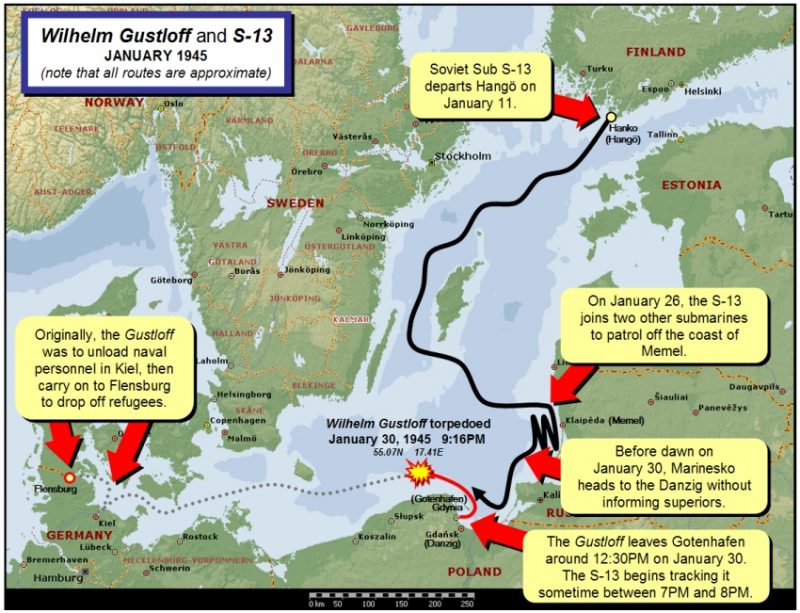
Sinking
The ship and her escorting torpedo boat were soon sighted by the Soviet submarine S-13, under the command of Captain Alexander Marinesko. The submarine sensor on board the escorting torpedo boat had frozen, rendering it inoperable as had Wilhelm Gustloff‘s anti-aircraft guns, leaving the vessels defenceless. Marinesko followed the ships for two hours before launching three torpedoes at Wilhelm Gustloff‘s port side about 30 km (16 nmi; 19 mi) offshore between Großendorf and Leba soon after 21:00 (CET), hitting it with all three (Marinesko intended to fire four torpedoes but the fourth misfired and the crew had to disarm it) The first torpedo (with text written on it: “For the Motherland”) struck near the port bow. The second torpedo (“For the Soviet people”) hit just ahead of midships. The third torpedo (“For Leningrad”) struck the engine room in the area below the ship’s funnel, cutting off electrical power to the ship. Wilhelm Gustloff took a light list to port and settled rapidly by the head. The fourth torpedo (disarmed) was named “For Stalin”.
The first torpedo caused the watertight doors to seal off the bow which contained the crews’ quarters where off-duty crew members were sleeping. The second torpedo hit the accommodations for the women’s naval auxiliary (located in the ship’s drained swimming pool); only three of the 373 quartered there survived. The third torpedo was a direct hit on the engine room, cutting all power and communications. Reportedly, only one lifeboat was able to be lowered, the rest had frozen in their davits and had to be broken free with some lost when they fell or capsized as a result of the panic. The water temperature in the Baltic Sea at that time of year is usually around 4 °C (39 °F); however, this was a particularly cold night, with an air temperature of −18 to −10 °C (0 to 14 °F) and ice floes covering the surface. Many deaths were caused either directly by the torpedoes or by drowning in the onrushing water. Others were crushed in the initial panic on the stairs and decks, and many jumped into the icy Baltic. The majority of those who perished succumbed to exposure in the freezing water.
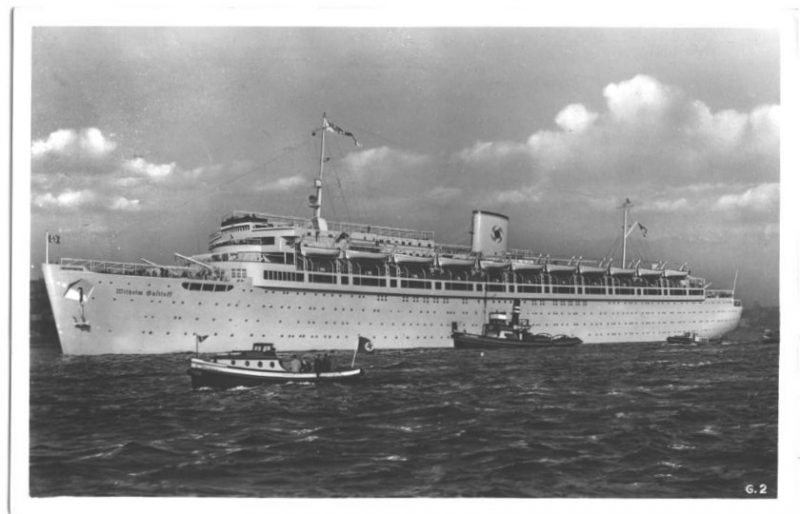
Less than 40 minutes after being struck, Wilhelm Gustloff was lying on her side and sank bow-first, in 44 m (144 ft) of water.
German forces were able to rescue some (a total of 1,252) of the survivors from the attack: torpedo boat T-36 rescued 564 people; torpedo boat Löwe, 472; minesweeper M387, 98; minesweeper M375, 43; minesweeper M341, 37; the steamer Göttingen saved 28; torpedo-recovery boat (torpedofangboot) TF19, seven; the freighter Gotland, two; and patrol boat V1703 was able to save one baby.
All four captains on Wilhelm Gustloff survived her sinking, but an official naval inquiry was started only against Wilhelm Zahn. His degree of responsibility was never resolved, however, because of Nazi Germany’s collapse in 1945.
The Losses
The figures from the research of Heinz Schön make the total lost in the sinking to be 9,343 total, including about 5,000 children.[
Heinz Schön’s more recent research is backed up by estimates made by a different method. An episode of Unsolved History that aired in March 2003 on the Discovery Channel program undertook a computer analysis of her sinking. Using software called maritime EXODUS it was estimated 9,400 people died out of more than 10,600 on board. This analysis considered the passenger density based on witness reports and a simulation of escape routes and survivability with the timeline of the sinking.
Many ships carrying civilians were sunk during the war by both the Allies and Axis. However, based on the latest estimates of passenger numbers and those known to be saved, Wilhelm Gustloff remains the largest loss of life resulting from the sinking of one vessel in maritime history. Günter Grass, in an interview published by The New York Times in April 2003, “One of the many reasons I wrote Crabwalk was to take the subject away from the extreme Right…They said the tragedy of Wilhelm Gustloff was a war crime. It wasn’t. It was terrible, but it was a result of war, a terrible result of war.”
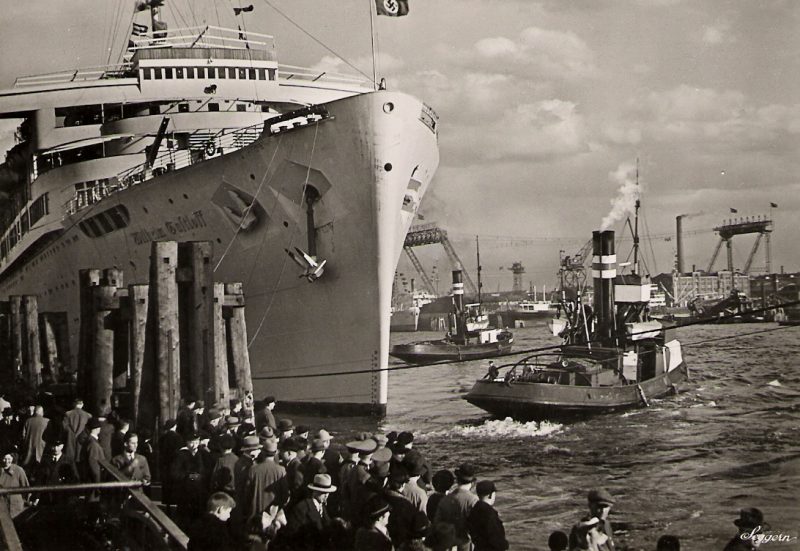
About 1,000 German naval officers and men were aboard during, and died in, the sinking of the Gustloff. The women on board the ship at the time of the sinking were inaccurately described by Soviet propaganda as “SS personnel from the German concentration camps”. There were, however, a number of female naval auxiliaries amongst the passengers.
On February 10, just 11 days after the sinking, S-13 sank another German ship, General von Steuben, killing about 3,000 people.
Before sinking Wilhelm Gustloff, Alexander Marinesko was facing a court martial due to his problems with alcohol and was thus deemed “not suitable to be a hero” for his actions and was instead awarded the Order of the Red Banner. Although widely recognized as a brilliant commander, he was downgraded in rank to lieutenant and dishonorably discharged from the navy in October 1945. In 1960 he was reinstated as captain third class and granted a full pension. In 1963 Marinesko was given the traditional ceremony due to a captain upon his successful return from a mission. He died three weeks later from cancer. Marinesko was posthumously awarded Hero of the Soviet Union by Mikhail Gorbachev in 1990